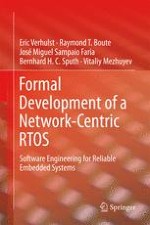2011 | OriginalPaper | Buchkapitel
3. The Choice of TLA+/TLC: Comparing Formal Methods
verfasst von : Eric Verhulst, Raymond T. Boute, José Miguel Sampaio Faria, Bernhard H. C. Sputh, Vitaliy Mezhuyev
Erschienen in: Formal Development of a Network-Centric RTOS
Verlag: Springer US
Aktivieren Sie unsere intelligente Suche, um passende Fachinhalte oder Patente zu finden.
Wählen Sie Textabschnitte aus um mit Künstlicher Intelligenz passenden Patente zu finden. powered by
Markieren Sie Textabschnitte, um KI-gestützt weitere passende Inhalte zu finden. powered by
